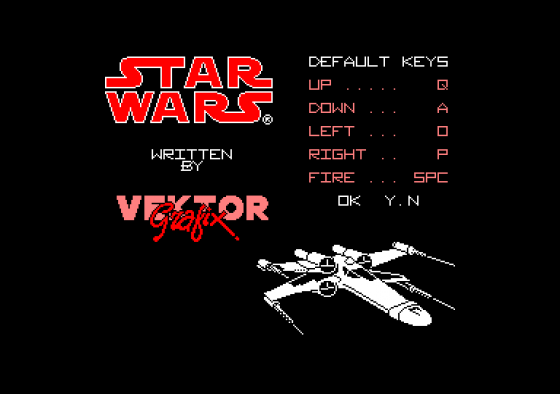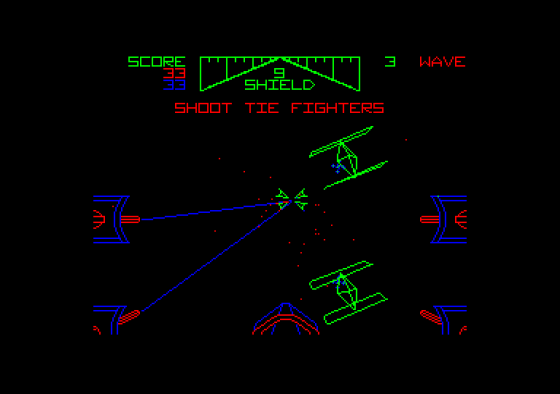
Amstrad Computer User
 1st March 1988
1st March 1988
Star Wars
A long, long time ago, in an amusement arcade far, far away, Atari launched an arcade machine. It is still the greatest film-tie in to be found in any arcade.
From Soho down to Brighton it still gets played, a real tribute to an ancient coin-op in these days of machine fashions and super hydraulics.
Several programmers have bought machines for their homes, Jeff "Llama man" Minter and Jez "Starglider" San, among them. So to produce a home computer version of the arcade classic is a daunting task.

Several companies tried to get the rights (better informed sources say that Activision fought very hard but lost!). After being impressed by the award-winning Trivial Pursuit conversion, Atari approached Domark.
It was not the first attempt to convert Star Wars, the rights were sold to Parker in 1983. They wrote Spectrum and C64 versions when Amstrad was still a twinkle in Alan Sugar's bank balance) but never released them. The public was lucky.
So Domark had the rights and took the project to Vektor Grafix in Leeds. They produced the 8-bit versions with the emphasis on being faithful to the arcade machine.

The game is split into three parts: Space battle, planet surface and trench.
In space you take on the federation's Tie fighters from your X-Wing. They shoot fireballs at you which you can either blast or dodge.
The Tie fighters can be shot and explode spectacularly. There is one indestructible enemy, Darth Vader's own craft. A hit causes it to spin and will stop the black baddie from shooting at you.

Humour has it that Darth Vader's ship can be destroyed with a number of hits, This is probably not true.
If your X-wing gets hit by a fireball, you lose a shield. You start with eight of these, effectively giving you a cat-like limit of nine lives.
Control is limited. The joystick moves a floating crosshair which aims the gun. You appear to have control over the movements of the ship, but this is an illusion. On completion of the level you fly into the Deathstar.
If the game is played at the easiest level - selected at the beginning of the game - you fly straight to the third part. Such a plan is for wimps.
The planet's surface is covered with towers, some capped by a white block. You have to blast all the blocks for a bonus.
Gun emplacements fire fireballs - in the Amstrad version these emplacements are invisible, a necessary programming sacrifice. The fireballs are real enough. Once again they will deplete your shield count - as will a collision with a tower.
No time to leap out and exchange insurance details, there are more towers to be shot and a time limit in which to do it.
The best tactic here seems to be to fly in one direction, blast all the tower tops and then fly in another direction.
Even if you fail to shoot all the towers you get moved on to the next stage.
As you fly into the Deathstar your task is to plant a shot at the exhaust port, just as Luke Skywalker did in the film.
The trench you have to fly down is well protected. There are fireball launching emplacements - much like those on the second level, and catwalks which cannot be shot.
Dodge 'em if you want to keep your shields. In fact it is better not to shoot at all.
By avoiding fireballs and not touching the trigger you can win a large bonus. This is know as "Using the Force". When the words - "Shoot exhaust port" appear, you may unleash a bolt of fire.
Mission accomplished, the Deathstar explodes and you are awarded bonus points for any shields left and three extra shields.
Then it's back to section 1 for another, tougher battle.
Nigel
There are a couple of Star Wars-like games around. The Realtime-coded Star Strike and Rainbird's StarGlider spring to mind.
They are both more playable but Star Strike has dreadful Mode 0 graphics, and StarGlider is more ambitious with missions and less of a shoot-'em-up.
The Domark game is amazingly faithful to the Atari original. Sometimes this has meant losing the kind of nice touches we have come to expect from home computer games.
Liz
Vektor Grafix share a building with Realtime - and what a powerhouse of programming they have up there in Leeds. This is their first major project, the Amstrad version being substantially better than the Spectrum conversion, despite both being written with the PDS assembler and ported separately.
It is playable, but as an old game it is showing its age. More a nostalgia purchase.
Colin
This is the first of the Domark Star Wars trilogy. The next title will be Return Of The Jedi. This flopped in the arcades. It deserved to, so I applaud Domark for their stated intent to beef it up a bit.
Then we will see Empire Strikes Back, another vector game, with more to do and some Starglider-type aliens. Of the three I suspect it will be Star Wars I come back to for another blast. May the Force be with you.



